
Laurel and Hardy were a British-American comedy team during the early Classical Hollywood era of American cinema, consisting of Englishman Stan Laurel (1890–1965) and American Oliver Hardy (1892–1957). Starting their career as a duo in the silent film era, they later successfully transitioned to "talkies". From the late 1920s to the mid-1950s, they were internationally famous for their slapstick comedy, with Laurel playing the clumsy, childlike friend to Hardy's pompous bully. Their signature theme song, known as "The Cuckoo Song", "Ku-Ku", or "The Dance of the Cuckoos" was heard over their films' opening credits, and became as emblematic of them as their bowler hats.

The Music Box is a Laurel and Hardy short film comedy released in 1932. It was directed by James Parrott, produced by Hal Roach and distributed by Metro-Goldwyn-Mayer. The film, which depicts the pair attempting to move a piano up a long flight of steps, won the first Academy Award for Best Live Action Short (Comedy) in 1932. In 1997, it was selected for preservation in the National Film Registry by the Library of Congress as being "culturally, historically, or aesthetically significant". The film is widely seen as the most iconic Laurel and Hardy short, with the featured stairs becoming a popular tourist attraction.
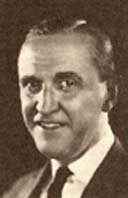
Harley M. Walker was a member of the Hal Roach Studios production company from 1916 until his resignation in 1932. The title cards he wrote for Harold Lloyd, Charley Chase, Our Gang and Laurel and Hardy comedies "have entered legend, both for silent films, and as opening remarks for the earlier talkies." He was also an officer of the Roach Studio corporation.

Laurel and Hardy were a motion picture comedy team whose official filmography consists of 106 films released between 1921 and 1951. Together they appeared in 34 silent shorts,A 45 sound shorts, and 27 full-length sound feature films.B In addition to these, Laurel and Hardy appeared in at least 20 foreign-language versions of their films and a promotional film, Galaxy of Stars (1936), produced for European film distributors.

James Henderson Finlayson was a Scottish actor who worked in both silent and sound comedies. Balding, with a fake moustache, he had many trademark comic mannerisms—including his squinting, outraged double-take reactions, and his characteristic exclamation: "D'ooooooh!" He is the best remembered comic foil of Laurel and Hardy.

Big Business is a 1929 silent Laurel and Hardy comedy short subject directed by James W. Horne and supervised by Leo McCarey from a McCarey (uncredited) and H. M. Walker script. The film, largely about tit-for-tat vandalism between Laurel and Hardy as Christmas tree salesmen and the man who rejects them, was deemed culturally significant and entered into the National Film Registry in 1992.

We Faw Down is a silent short subject directed by Leo McCarey starring comedy duo Laurel and Hardy. It was released by Metro-Goldwyn-Mayer on December 29, 1928. It was remade in part with their film Sons of the Desert in 1933.

You're Darn Tootin' is a silent short subject directed by E. Livingston Kennedy starring comedy duo Laurel and Hardy. It was released on April 21, 1928, by Metro-Goldwyn-Mayer.

Unaccustomed As We Are is the first sound film comedy starring Stan Laurel and Oliver Hardy, released on May 4, 1929.
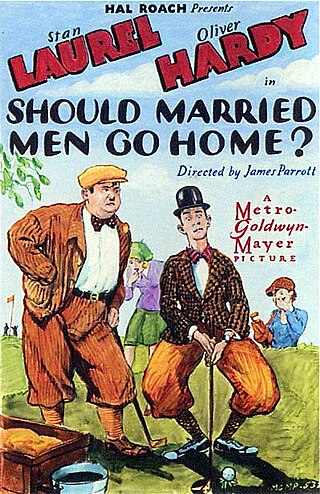
Should Married Men Go Home? is a silent short subject co-directed by Leo McCarey and James Parrott, starring comedy duo Laurel and Hardy. It was the first Hal Roach film to bill Laurel and Hardy as a team. Previous appearances together were billed under the Roach "All-Star Comedy" banner. It was released by Metro-Goldwyn-Mayer on September 8, 1928. McCarey is also one of the script writers for the film.

Habeas Corpus is a silent short subject co-directed by Leo McCarey and James Parrott starring comedy duo Laurel and Hardy. It was released by Metro-Goldwyn-Mayer on December 1, 1928
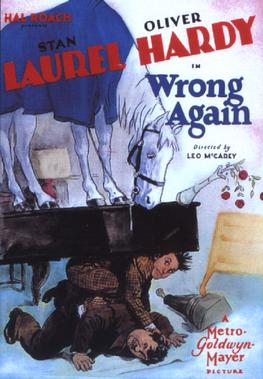
Wrong Again is a 1929 American two-reel silent comedy film directed by Leo McCarey and starring Laurel and Hardy. It was filmed in October and November 1928, and released February 23, 1929, by Metro-Goldwyn-Mayer. Although a silent film, it was released with a synchronized music and sound-effects track in theaters equipped for sound.
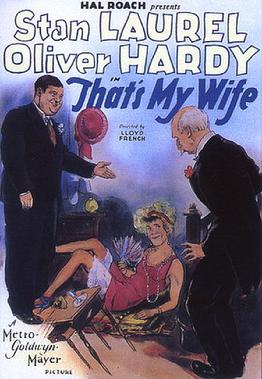
That's My Wife is a 1929 short comedy silent film produced by the Hal Roach Studios and starring Laurel and Hardy. It was shot in December 1928 and released March 23, 1929, by Metro-Goldwyn-Mayer with a synchronized music and sound effects track in theaters equipped for sound.
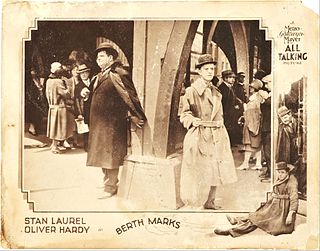
Berth Marks is the second sound film starring Laurel and Hardy and was released on June 1, 1929.

Be Big! is a Hal Roach three-reel comedy starring Laurel and Hardy. It was shot in November and December 1930, and released on February 7, 1931.

Laughing Gravy is a 1931 short film comedy starring Laurel and Hardy. It was directed by James W. Horne, produced by Hal Roach and distributed by Metro-Goldwyn-Mayer.
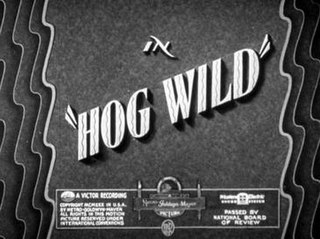
Hog Wild is a 1930 American pre-Code Laurel and Hardy film, directed by James Parrott.

The Live Ghost is a 1934 American comedy short film starring Laurel and Hardy, directed by Charles Rogers, and produced by Hal Roach at his studios in Culver City, California.

County Hospital is a Laurel and Hardy short film made in 1932. It was directed by James Parrott, produced by Hal Roach and distributed by Metro-Goldwyn-Mayer. Ollie is in hospital with a broken leg, Stan comes to visit and ends up getting Ollie kicked out; on the way home Stan crashes the car.

Randy Skretvedt is an American film and music scholar, author, lecturer and broadcaster. His 1987 book Laurel and Hardy: The Magic Behind the Movies is the reference standard for Laurel and Hardy fans. In 2016, Skretvedt put the book through a massive update and enhancement, retitling it LAUREL AND HARDY: THE MAGIC BEHIND THE MOVIES and publishing it through Bonaventure Press as an oversized 8-1/2 x 11 hardcover book, increasing the text by 50% and quadrupling the number of pictures included. Early supporters of the Kickstarter campaign for this edition also received a custom audio CD of selected excerpts from Mr. Skretvedt's interviews with Laurel and Hardy colleagues and co-workers.




















